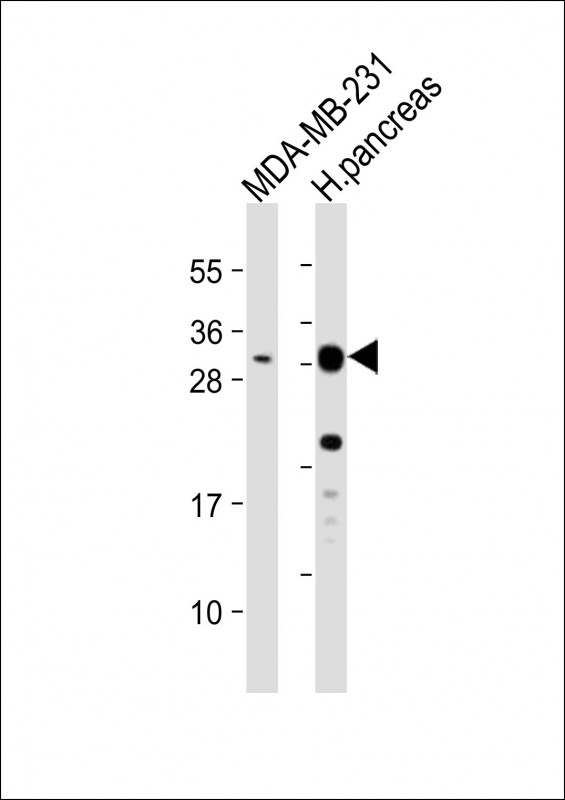PRSS3 Antibody (Center)
Affinity Purified Rabbit Polyclonal Antibody (Pab)
- SPECIFICATION
- CITATIONS: 1
- PROTOCOLS
- BACKGROUND

Application
| WB, FC, IHC-P, E |
|---|---|
| Primary Accession | P35030 |
| Other Accession | NP_002762.2 |
| Reactivity | Human |
| Host | Rabbit |
| Clonality | Polyclonal |
| Isotype | Rabbit IgG |
| Calculated MW | 32529 Da |
| Antigen Region | 136-163 aa |
| Gene ID | 5646 |
|---|---|
| Other Names | Trypsin-3, Brain trypsinogen, Mesotrypsinogen, Serine protease 3, Serine protease 4, Trypsin III, Trypsin IV, PRSS3, PRSS4, TRY3, TRY4 |
| Target/Specificity | This PRSS3 antibody is generated from rabbits immunized with a KLH conjugated synthetic peptide between 136-163 amino acids from the Central region of human PRSS3. |
| Dilution | WB~~1:1000 FC~~1:10~50 IHC-P~~1:10~50 E~~Use at an assay dependent concentration. |
| Format | Purified polyclonal antibody supplied in PBS with 0.09% (W/V) sodium azide. This antibody is purified through a protein A column, followed by peptide affinity purification. |
| Storage | Maintain refrigerated at 2-8°C for up to 2 weeks. For long term storage store at -20°C in small aliquots to prevent freeze-thaw cycles. |
| Precautions | PRSS3 Antibody (Center) is for research use only and not for use in diagnostic or therapeutic procedures. |
| Name | PRSS3 |
|---|---|
| Synonyms | PRSS4, TRY3, TRY4 |
| Function | Digestive protease that cleaves proteins preferentially after an Arg residue and has proteolytic activity toward Kunitz-type trypsin inhibitors. |
| Cellular Location | Secreted. |
| Tissue Location | Detected in pancreas and pancreatic fluid (at protein level) (PubMed:6698368). Expressed in pancreas and brain (PubMed:8294000). Detected in ileum (PubMed:12021776) |

Provided below are standard protocols that you may find useful for product applications.
Background
This gene encodes a trypsinogen, which is a member of the trypsin family of serine proteases. This enzyme is expressed in the brain and pancreas and is resistant to common trypsin inhibitors. It is active on peptide linkages involving the carboxyl group of lysine or arginine. This gene is localized to the locus of T cell receptor beta variable orphans on chromosome 9. Four transcript variants encoding different isoforms have been described for this gene.
References
Jiang, G., et al. Gut 59(11):1535-1544(2010)
Nakanishi, J., et al. J. Invest. Dermatol. 130(4):944-952(2010)
Salameh, M.A., et al. J. Biol. Chem. 285(3):1939-1949(2010)
Rosendahl, J., et al. Pancreatology 10 (2-3), 243-249 (2010) :
Koistinen, H., et al. Neuroscience 160(1):97-102(2009)
If you have used an Abcepta product and would like to share how it has performed, please click on the "Submit Review" button and provide the requested information. Our staff will examine and post your review and contact you if needed.
If you have any additional inquiries please email technical services at tech@abcepta.com.














 Foundational characteristics of cancer include proliferation, angiogenesis, migration, evasion of apoptosis, and cellular immortality. Find key markers for these cellular processes and antibodies to detect them.
Foundational characteristics of cancer include proliferation, angiogenesis, migration, evasion of apoptosis, and cellular immortality. Find key markers for these cellular processes and antibodies to detect them. The SUMOplot™ Analysis Program predicts and scores sumoylation sites in your protein. SUMOylation is a post-translational modification involved in various cellular processes, such as nuclear-cytosolic transport, transcriptional regulation, apoptosis, protein stability, response to stress, and progression through the cell cycle.
The SUMOplot™ Analysis Program predicts and scores sumoylation sites in your protein. SUMOylation is a post-translational modification involved in various cellular processes, such as nuclear-cytosolic transport, transcriptional regulation, apoptosis, protein stability, response to stress, and progression through the cell cycle. The Autophagy Receptor Motif Plotter predicts and scores autophagy receptor binding sites in your protein. Identifying proteins connected to this pathway is critical to understanding the role of autophagy in physiological as well as pathological processes such as development, differentiation, neurodegenerative diseases, stress, infection, and cancer.
The Autophagy Receptor Motif Plotter predicts and scores autophagy receptor binding sites in your protein. Identifying proteins connected to this pathway is critical to understanding the role of autophagy in physiological as well as pathological processes such as development, differentiation, neurodegenerative diseases, stress, infection, and cancer.



